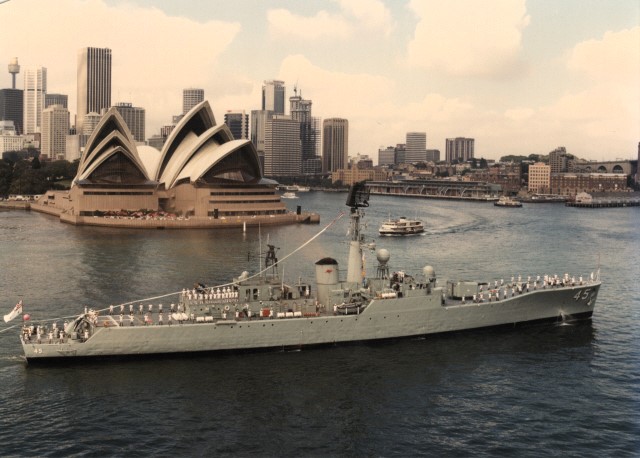Commissioned on 27 July 1961 HMAS Yarra underwent significant configuration enhancements during its 24 years of distinguished service in the Royal Australian Navy. Its major refits involved the installation of the Australian designed and developed systems. Initially the Ikara missile system and later the Mulloka sonar.
On commissioning Yarra was fitted with two Limbo triple-barrelled anti-submarine mortars and two 40mm Bofors. These were later removed.

|
|
In July 1966 Yarra entered an eight-month refit at Williamstown Naval Dockyard. Work undertaken included the installation of the Ikara missile system with post refit trials commencing in February 1967. Sea acceptance trials on the Ikara system continued until September 1967 when Yarra deployed on a six-month deployment to the Far East Station.
The following extract from ‘IKARA Australia’s Cold War Wonder Weapon’ describes the excellent operational performance of Ikara during that deployment.
Yarra’s performance on deployment with the Strategic Reserve at Singapore in late 1967 was highly encouraging, particularly in an October firing exercise accompanied by Stuart and the British submarine HMS Anchorite. As her CO, then Captain Robertson, recalled this shoot was the first outside Australian waters, and did not enjoy the available support of RAN and civilian contractor technicians. “The Flag Officer Second-in-Command of the Far East (FO2FEF) (Rear-Admiral Hughes-Hallett) came onboard for the event and was most impressed with the simplicity of the firing, the flexibility when we were required to change our firing area, the superb clean engineering of the installation, and its proven accuracy and reliability. The firing was at long range and the submarine reported that it could hear the torpedo circling overhead. The Admiral stated that the Royal Navy must have the weapon and that he would immediately raise the matter with the Admiralty.”

In July 1974 Yarra was once again back in the Williamstown Dockyard to be fitted with Mulloka sonar. This refit lasted until early 1975. Yarra was then utilised almost exclusively for the remainder of 1975 and most of 1976 as the Mulloka trials ship. Early issues with Mulloka’s ability to make accurate contacts beyond short ranges were eventually overcome, and in April 1978 the ship obtained excellent results with two Ikara launches relying on Mulloka alone.
Preparations for Yarra’s half-life refit commenced in September 1976 with the ship decommissioned on 11 October 1976 for refit at Cockatoo Island Dockyard, Sydney. Her sister ships underwent a more comprehensive life of type extension refits at Williamstown Dockyard.
During this refit the major configuration changes included removal of the Mk 10 anti-submarine mortar, replacement of the prototype Mulloka sonar with an upgraded prototype and a complete overhaul of weapons, machinery and accommodation. In addition, the ship was converted to burn diesel fuel rather than heavy oil and the 4.5-gun mounting exchanged with a modernised one.

HMAS Yarra’s last seven years of service, in addition to completing Mulloka sonar trials included, Fleet exercises, Pacific and Southeast Asian deployments and a 10 month refit at Sydney from October 1980 when the mortar well was enclosed.

References
- Angus Britts, IKARA Australia’s Cold War Wonder Weapon, Naval Historical Society of Australia
- HMAS Yarra (III) History, Sea Power Centre Australia.
John Jeremy, KEEPING THE SHIPS AT SEA-Ship Repair at Cockatoo Island 1857 to 1991, Sydney Harbour Federation Trust.





